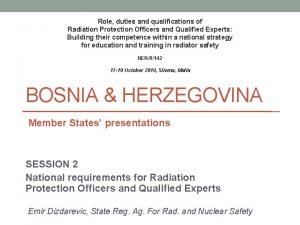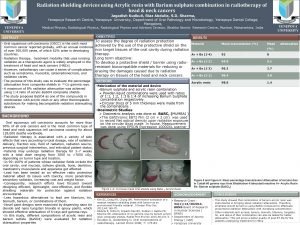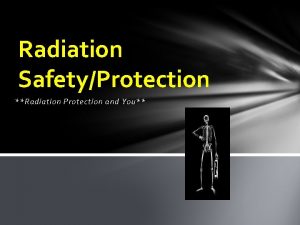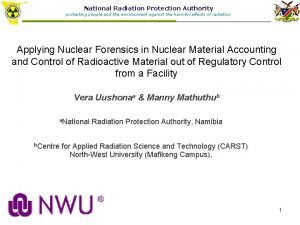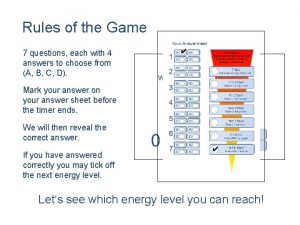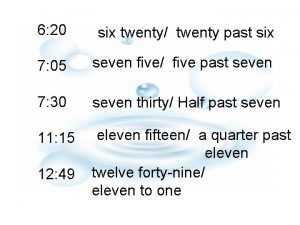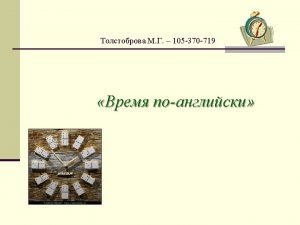Twenty Questions Radiation Protection Radiation Protection Questions 1






















- Slides: 22

Twenty Questions Radiation Protection

Radiation Protection Questions 1 2 3 4 5 6 7 8 9 10 11 12 13 14 15 16 17 18 19 20

1. The traditional unit of measure for the equivalent dose (Eq. D) is the _____. �Sievert (Rem)

2. This consists of two protons and two neutrons. �Alpha Particle.

3. The millisievert (m. Sv) is a subunit of the Sievert. One Sievert equals _______ millisieverts. � 1000

4. The radiation interaction with tissue that involves ejecting a K-shell electron is called? �Photoelectric effect

5. The most common type of naturally occurring radiation is: �Radon – Radon makes up about 55% of all natural and manmade radiation exposures in the U. S.

6. Naturally occurring background radiation that comes from the sun and stars is called____. �Cosmic Radiation

7. Referring to the chart, is there more natural or man-made radiation exposure for the average U. S. citizen? �Natural.

8. What phase of cellular division belongs where letter A is on the diagram? �Metaphase

9. What is the annual occupational effective dose for radiographers during routine operations? � 50 m. Sv or 5 rem

10. When exposed to radiation as a part of their educational experience, students under the age of 18 years old, should not exceed an effective dose limit of _______ annually. � 1 m. Sv or. 1 rem

11. Determine the cumulative effective dose (Cum. Ef. D) to the whole body of an occupationally exposed person who is 27 years old. � 270 m. Sv or 27 Rem � 10 m. Sv X Age or 1 Rem x Age

12. Cancer & Genetic defects are examples of ______ effects. A. B. C. D. Stochastic Nonstochastic Birth Deterministic �Stochastic effects are mutational, non-threshold, randomly occurring effects. �Non-stochastic or deterministic effects can be directly linked to a radiation event.

13. Which of the following curves represents a non-linear threshold response. �Curve 3.

14. Which of the following curves represents the standard on which radiation dose limits are set? �Curve 1 Linear - non threshold

15. The lethal dose of ionizing radiation for humans is stated as: �The LD 50/30 is 300 – 400 Rads Sometimes this is expressed as the LD 50/60 �Under 100 rad, no death is expected. �Without medical support, death to the entire population occurs at about 600 Rad.

16. What do basal cells of the skin, intestinal crypt cells and reproductive cells have in common? �All cells are radiosensitive �Lymphocytes, spermatogonia, erythroblasts, DNA molecules & intestinal crypt cells are highly radiosensitive �Muscle & nerve cells have low radiosensitivity

17. Which of the following are classified as high LET Radiations? Alpha particles Gamma Rays X-rays �Alpha particles only

18. Which molecules of the human body are most commonly acted on by ionizing radiation to produce molecular damage through and indirect action? �Water Molecules

19. The law of Bergonie and Tribondeau takes into account that the most pronounced radiation effects occur in cells having the _(most/least) reproductive activity, (longest/shortest) mitotic phases and (most/least) maturity. �Most Reproductive, longest mitotic phase, least maturity

20. Somatic cells divide through the process of: �Mitosis - Somatic cells are all general cells in the body �Meiosis is the division of the genetic or germ cells
 20 question questions
20 question questions Radiation protection officer qualifications
Radiation protection officer qualifications Barium sulphate board for radiation protection
Barium sulphate board for radiation protection Cardinal principles of radiation protection
Cardinal principles of radiation protection National radiation protection authority namibia
National radiation protection authority namibia Twenty questions text games
Twenty questions text games Twenty questions original network
Twenty questions original network Twenty questions christmas
Twenty questions christmas Twenty questions rules
Twenty questions rules Twenty questions
Twenty questions 20 questions
20 questions Aa twenty questions
Aa twenty questions It's quarter to twelve
It's quarter to twelve 20 point programme was introduced by
20 point programme was introduced by It's twenty past six
It's twenty past six Literary devices in after twenty years
Literary devices in after twenty years Four score and ten years ago
Four score and ten years ago Consumer culture theory (cct): twenty years of research
Consumer culture theory (cct): twenty years of research Summary after twenty years
Summary after twenty years Twenty past 1
Twenty past 1 It is ten past nine
It is ten past nine Whats a quarter past 5
Whats a quarter past 5 Under the sea characters
Under the sea characters

